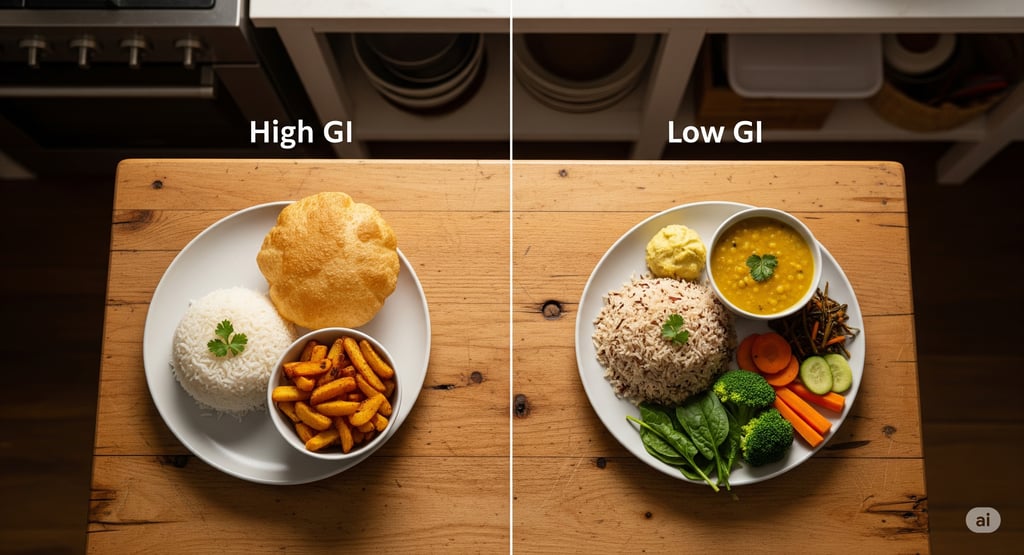More Than Just Sugar: A Simple Guide to Understanding the Glycemic Index
Trulo team
8/21/20253 min read


When we think about healthy eating, our minds often jump to "sugar." We know that sugary drinks and sweets can cause a quick energy spike and a sudden crash. But what if we told you that not all carbohydrates are created equal, and some can have a similar effect to sugar, even if they don't taste sweet?
This is where the Glycemic Index (GI) comes in. Think of the GI as a simple tool that helps us understand how quickly a carbohydrate-containing food raises our blood sugar levels
The Traffic Analogy: High GI vs. Low GI
Let's imagine our body's bloodstream is a highway.
High GI Foods are like a sports car on an empty highway. They are digested and absorbed very quickly, causing a rapid and dramatic surge in blood sugar. This gives you a fast burst of energy, but it's often followed by a crash, leaving you feeling tired and hungry again soon after. Think of a sudden sugar rush.
Low GI Foods are like a family car in city traffic. They are digested slowly and steadily, leading to a gradual and sustained rise in blood sugar. This provides a steady flow of energy that lasts longer, helping you feel full and energized for hours.
GI in the Indian Kitchen: A Simple Guide
Now, let's apply this to the foods we eat every day in India.
The "Fast Lane" (High GI)
These are foods that are quickly broken down and can cause a rapid spike in blood sugar. We don't have to avoid them completely, but it's good to be mindful of how and when we eat them.
White Rice (especially simple steamed rice): White rice is a staple, but it’s high GI. It’s digested quickly, releasing glucose into the bloodstream at a rapid pace.
Maida (White Flour): The flour used in refined breads like naan, puri, and bhature is high GI because it has been stripped of its fiber, which slows down digestion.
Potatoes: While they have nutrients, potatoes are a high GI vegetable, especially when mashed or fried, as their starches are easily digestible.
The "Middle Ground" (Medium GI)
These foods are a great choice for providing sustained energy without the dramatic spike.
Whole Wheat Chapati: Unlike maida, the fiber in whole wheat slows down the release of sugar.
Basmati Rice: Some types of basmati rice have a slightly lower GI than other white rice varieties due to their starch composition.
The "Slow and Steady" (Low GI)
These are our superstars. They keep us full, energised, and our blood sugar levels stable.
Dals and Legumes (e.g., Chana, Rajma, Moong, Masoor): The high fiber and protein content in dals make them digest slowly, providing a wonderful, steady source of energy.
Millets (e.g., Ragi, Bajra, Jowar): These ancient grains are packed with fiber and are excellent low GI alternatives to traditional flours and rice.
Most Vegetables: Non-starchy vegetables like cauliflower, cabbage, leafy greens, and bell peppers are low GI and perfect for filling up your plate.
Nuts and Seeds: Rich in healthy fats, protein, and fiber, they are excellent low GI snack options.
How to Use GI to Your Advantage
The goal of understanding the GI isn’t to label foods as "good" or "bad." It's about empowering you to build balanced meals that support your health and well-being.
Here are some simple tips:
Pair and Balance: The magic of the Indian thali is that it naturally balances GI! Pair your rice or chapati (high/medium GI) with a generous serving of dal (low GI) and a vegetable dish (low GI) to slow down the overall absorption of sugar.
Embrace Millets: Try swapping a portion of your rice or wheat flour with millets like ragi or bajra. Ragi rotis and bajra khichdi are delicious and healthy alternatives.
Start with the Good Stuff: Begin your meal with a serving of salad or a bowl of dal. This can help slow down the digestion of subsequent high-GI foods.
Don't Overcook: Cooking certain starches for too long can increase their GI. Aim for al dente pasta or rice that isn't overly mushy.
Understanding the Glycemic Index is a powerful step towards a healthier lifestyle. It helps us see that a meal is more than just the sum of its parts: it's about how those parts work together to give us lasting energy and a stable body. So, next time you plan a meal, think about building a plate that’s not just colourful, but also balanced for that steady, long-lasting energy.
